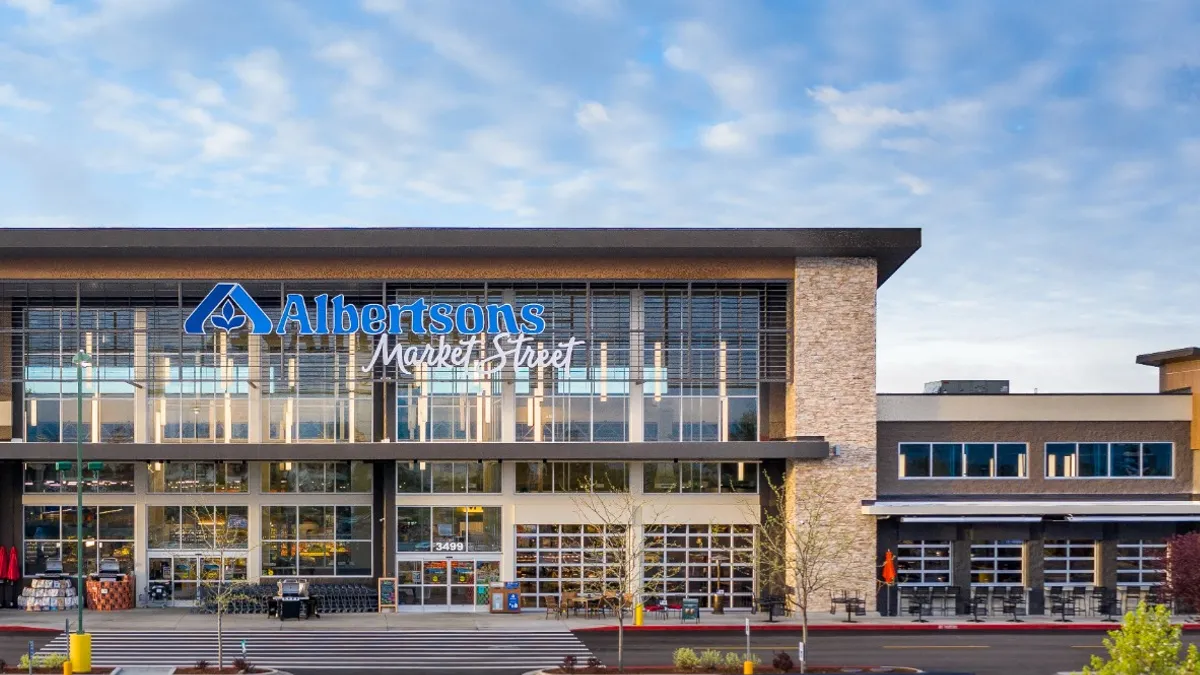Dive Brief:
- Albertsons is seeing increasing signs that its investment in automated micro-fulfillment technology will help improve the economics of its e-commerce business, CEO Vivek Sankaran said on Friday during Citigroup’s Retail Madness Virtual Conference. “We see a lot of promise in the ability of an MFC to get that cost down so that the [grocer’s digital] business is profitable and equivalent to what our core business is,” Sankaran said.
- Drive Up & Go, Albertsons' curbside service, is the fastest-growing component of the grocer’s business, which Sankaran attributed to the ability of consumers to decide for themselves when to pick up their orders.
- As e-commerce sales levels remain elevated, Albertsons plans to shift its testing of MFC technology into the next phase by opening seven MFCs this year.
Dive Insight:
E-commerce could eventually comprise 20% of Albertsons’ business, which would be beneficial for the company because it is able to connect better with consumers when they make purchases digitally, Sankaran said. But it also requires a lot of adjustments to improve the economics of its backend operations.
Sankaran said Albertsons has recently rethought the picking, slotting and scheduling algorithms that underlie its e-commerce operations. The company has offloaded delivery to third-party providers in certain markets. It is also determined to lower the cost of picking an order — which is where MFC technology comes into play. Albertsons, which has been piloting two MFCs for a little over a year, intends to open seven new facilities during 2021, Sankaran said.
He noted that MFCs are especially beneficial in dense areas and said he sees a single facility serving between six and 10 stores. He declined to say how many MFCs he expects Albertsons to ultimately open across its fleet of more than 2,200 supermarkets.
Albertsons was one of the first grocery chains to pilot micro-fulfillment technology. And it remains a vocal supporter of MFCs even as the conversation around fulfillment now includes a range of options including manual-pick dark stores, enhanced in-store fulfillment and large automated facilities like the ones Kroger is set to soon unveil publicly with Ocado. Earlier this year, Walmart announced it's taking the next step in its rollout of micro-fulfillment technology, adding automated MFCs to dozens of stores.
Sankaran also said he expects consumers to continue turning to supermarkets and trading up with their purchasing. In a reflection of that, Albertsons has seen a marked increase in sales of products like shellfish and premium wine in recent months, he said.
“I think people have enjoyed higher quality food at home over the last several months, and my sense is that given people have money and have enjoyed higher quality product, there'll be a desire for the continued consumption of that higher quality product," Sankaran noted. "So I don't see that behavior changing dramatically unless there's massive amounts of inflation, and I'm not seeing that either.”
Sankaran said he expects inflation to decline from a current range of 3%-4% to between 1% and 2% during the second half of 2021, which he said bodes well for the company. He said while grocers can generally pass price bumps of up to 4% on to consumers, increases above that rate can pose a challenge.
“We like to be conservative, we like to manage the business around 1-2% inflation, and design the P and L behind that. And if it turns out to be a little higher than that, it typically works in our favor when it’s moderate like that,” he said.
Sankaran added that he believes economic conditions are stronger than he had expected they would be when the pandemic struck early last year — a phenomenon that he said plays to the grocery industry’s favor.
“Around this time in 2020, I imagined that we would come out of this pandemic with absolute carnage, with households really short of money, and such. It's remarkable that it's almost the opposite,” with people’s savings having gone up and the latest round of stimulus checks from the federal government now being distributed, Sankaran said.
Sankaran also said Albertsons’ private label sales have recently increased as supplies have improved and people’s buying patterns have stabilized. Starting late in the last quarter, the company saw penetration of its own brands rise to 25%, where it had been before the pandemic, after panic buying and other shifts in shopping habits lowered its market share. The company has continued to see private label sales at that level in recent weeks and hopes to see the rate increase to 30%, he said.
“I believe we will always remain a house of brands, no question about that," Sankaran said. "There'll be A brands and B brands. And I think in the United States it's going to be harder and harder for C brands and D brands to continue to win, because we've all developed, and we certainly have developed ... a pretty powerful own brand portfolio."













